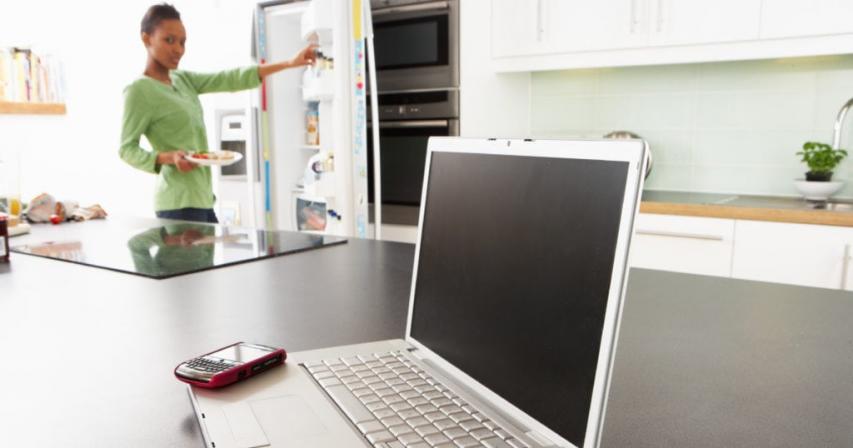10 Tips for Eating Healthy When You’re Working From Home

Keeping your nutrition in check can be tough when your home is your office. You feel comfortable and there’s plenty of food available. And unlike in the office, you’re free to graze all day and the fridge is all yours. But this habit can wreak havoc on your waistline, sabotage weight loss and halt your productivity.
Don’t work in (or near) the kitchen.
Try to set up your desk in an area that’s not near the kitchen. You might be tempted to wander over and check the fridge (for the tenth time) if it’s constantly in your line of vision. Decide that the only time you’ll be in your kitchen during the workday is when you’re getting ready to have a planned snack or meal. (More on that below!) If this is hard to follow, hang a sign on your fridge and pantry to remind you that the kitchen is closed until the next scheduled meal or snack.
Plan your snack and meal times.
Just as you schedule and plan out the rest of your day (get up, workout, shower), establish when throughout the day you’re going to eat. If you know you like to eat lunch around noon, plan for that. And if you like to have a snack in the late afternoon, plan for that as well. Treat food like you would in the office. You can’t be grazing all day long when you’re there – so act the same way at home.
Make sure you actually eat.
Once you hit the ground running, err, working, it can be hard to take a break to actually eat. But it’s important to know your hunger signs and realize that not eating can affect your alertness and productivity. Plus, eating throughout the day can save you from being a big hangry mess once 5 o’clock rolls around. If needed, set an alarm on your phone to remind you to get up and eat something.
Meal prep your lunches.
There’s something freeing about being able to whip up whatever you want to eat for lunch (and not having to stand in line for the work microwave is a huge bonus). But for some people, the freedom is too much, especially when it comes to weekday lunches. If you can, try to meal prep your lunches ahead of time, just like you would on days you physically go to work. It doesn’t need to be anything fancy either. A bag of lettuce, precut veggies, grilled chicken and nuts is a simple form of meal prep that takes out all the guess work. Or maybe you’ve decided that you’re going to make a veggie omelet every day for lunch. Precut the vegetables ahead of time so you can quickly cook up a healthy and delicious lunch.
Focus on real food.
Balanced, nutritious food makes us more productive. It keeps us fuller longer and helps us focus. Understand that what you eat will impact your mood and energy level. Think about this the next time you’re feeling hungry and just want to grab a handful of chocolate from the pantry. Focus on protein, fiber, healthy fats, fruits and veggies. Planning a menu ahead of time will make it easier to avoid noshing on whatever looks tastiest and quickest in the moment.
Drink plenty of water.
Dehydration can lead to headaches and fatigue, which are both not good for your productivity. Just as you’d fill up a water bottle at the office to keep at your desk, keep water next to your work station at home too. If you have water readily available, chances are you’re more likely to drink it, helping you reach your goal of at least 64 ounces per day. (And PLEASE stay away from sugar-loaded soda and juice, both of which can cause you to crash later.)
Be careful of too much caffeine.
Having access to endless cups of coffee might seem like a great idea, but tread carefully when it comes to caffeine. Too much is known to cause headaches, anxiety, digestive issues and even fatigue – none of which are ever good, but particularly not good when you’re trying to work. Aim for no more than two cups of coffee per day to avoid the jittery feeling and avoid flavored creamers and other high calorie add-ins!
Don’t buy junk food.
Don’t stock your fridge or pantry like a vending machine. This can lead to eating just because you can! Try you best to keep junk food out of your house, especially foods you know can trigger a binge for you. Out of sight, out of mind.
When you eat, just eat.
You might be tempted to continue working through your lunch break now that your co-workers aren’t physically there. Bu don’t do it! Being distracted during a meal can lead to over-eating and decreased satiety (satisfaction and fullness) from the meal. Instead, take a break from work to sit down at a table to enjoy your lunch and relax for a few minutes. You’ll enjoy the meal more, and it may even help you feel more prepared for the rest of your work day.
Portion out snacks and meals before eating.
Never eat out of the bag or original container, as it’s much harder to control portions that way. Check the serving size on the container if you need extra guidance. For meals, try the healthy plate method: Fill half a 9-inch plate with non-starchy vegetables, one-fourth the plate with a lean protein (poultry, seafood, beans, eggs, tofu, cottage cheese or Greek yogurt) and one-fourth the plate with a high fiber carbohydrate (fruit, whole grains or starchy vegetables).






Comments